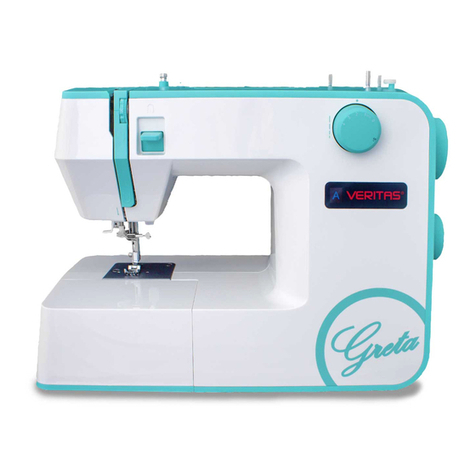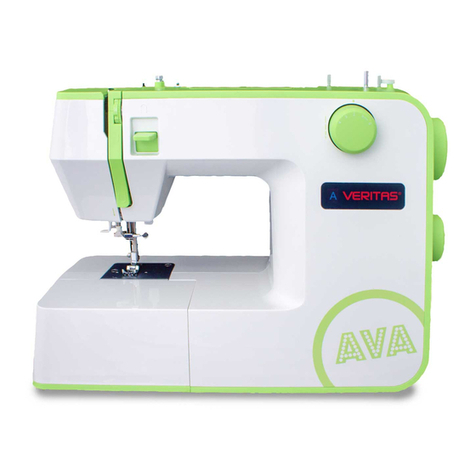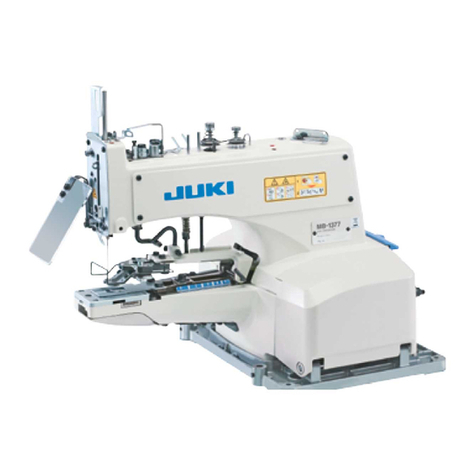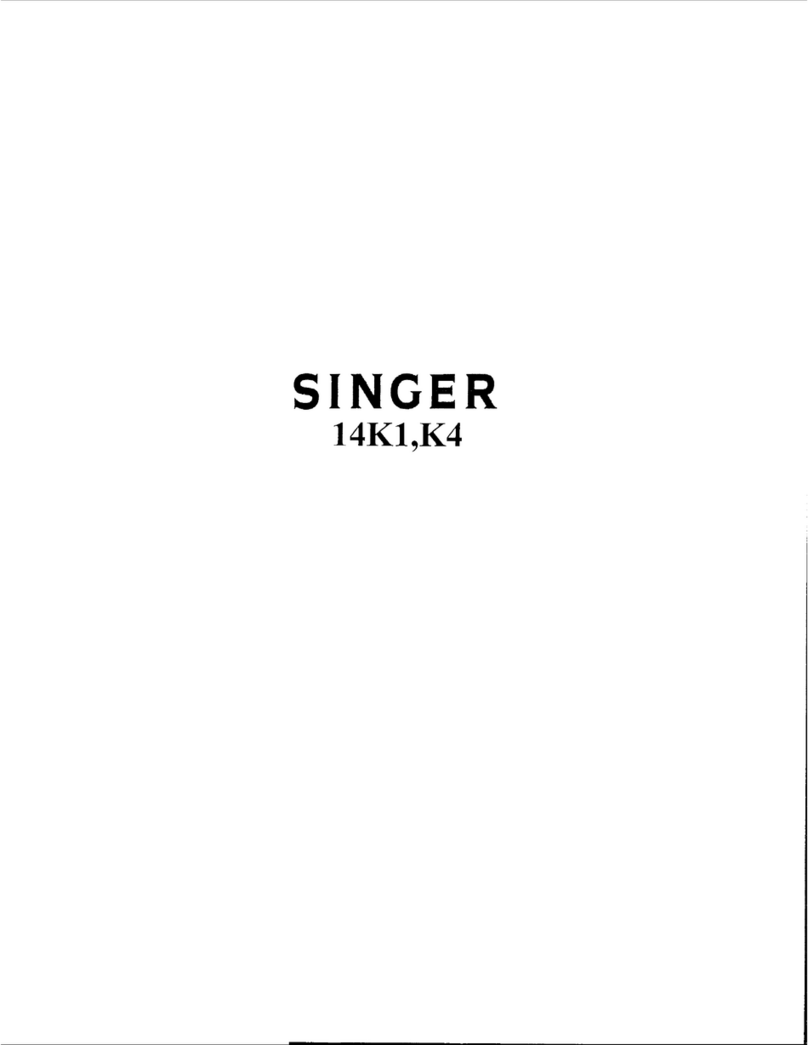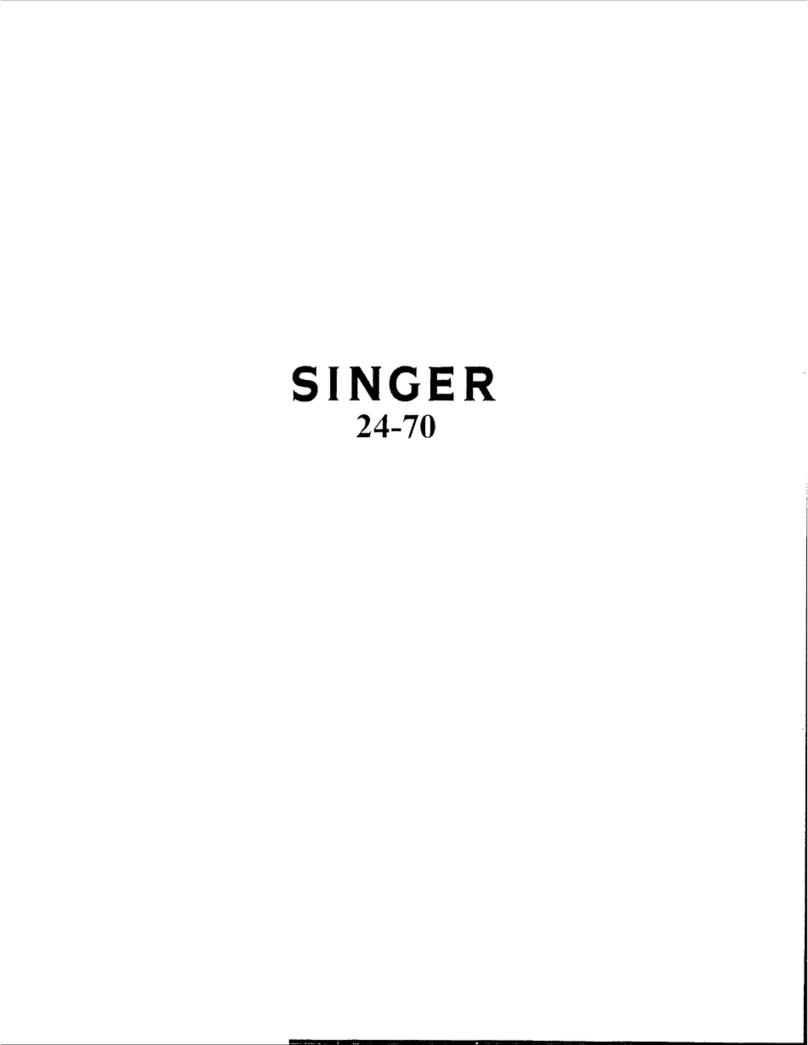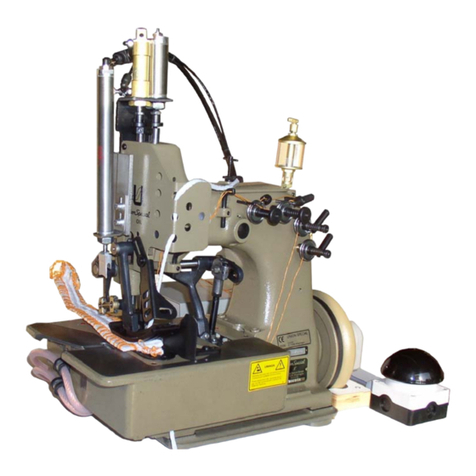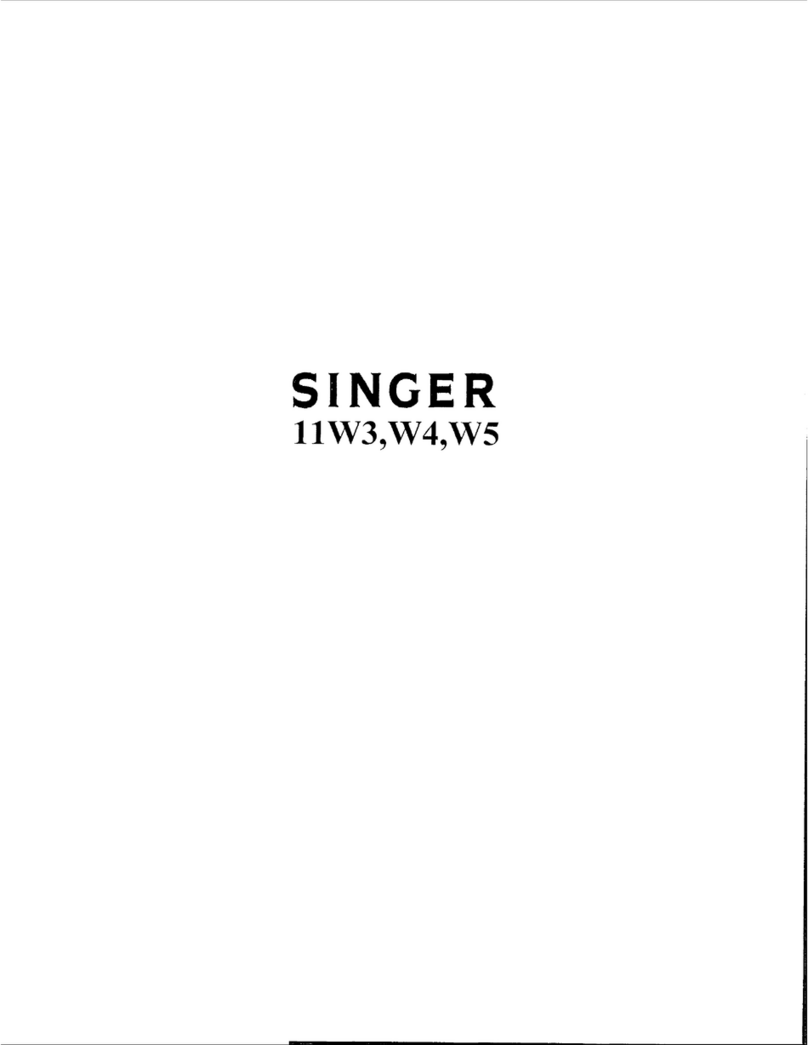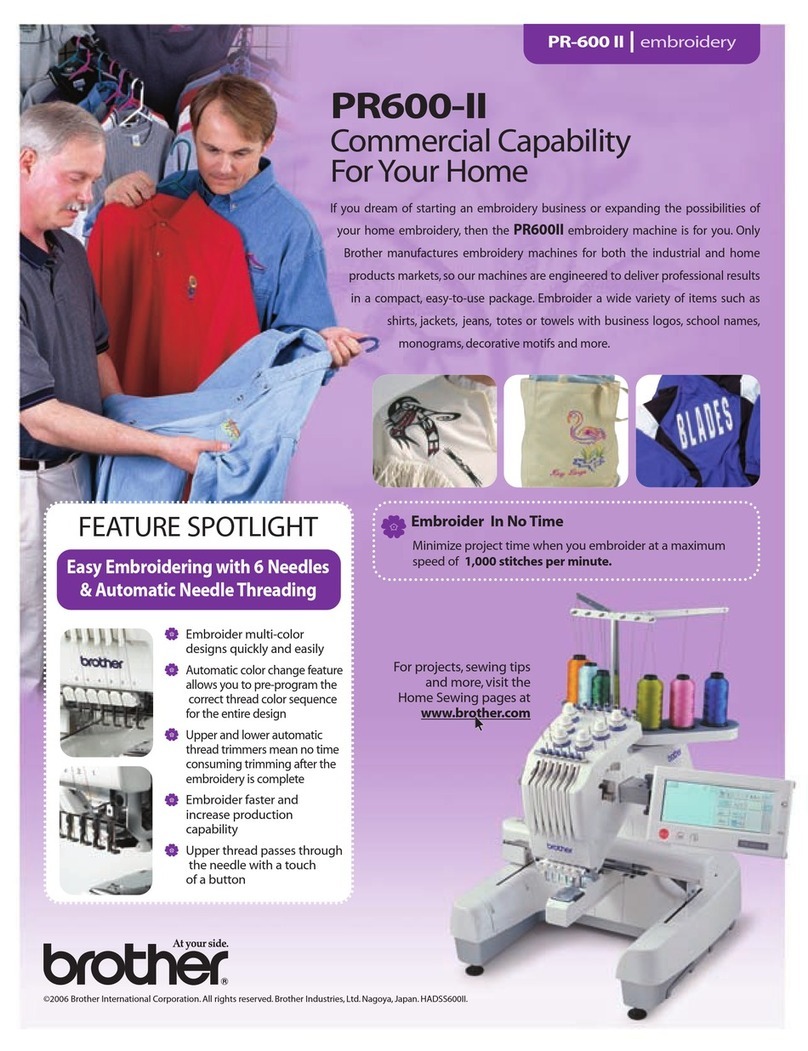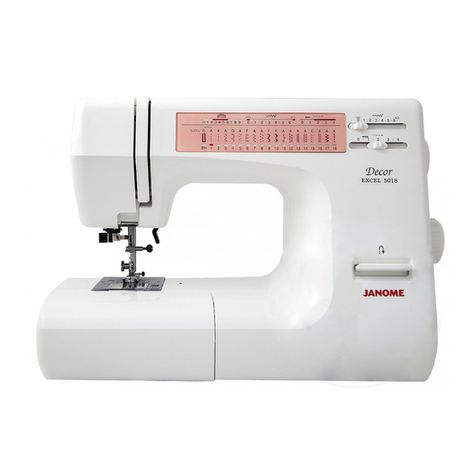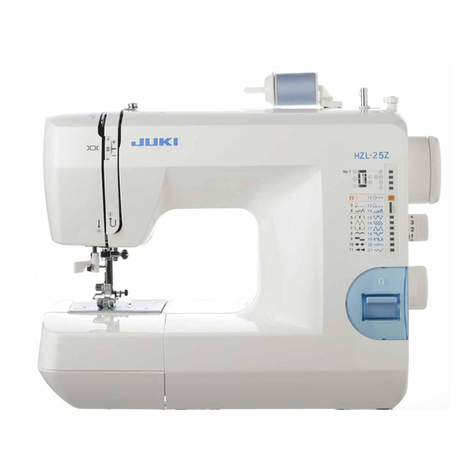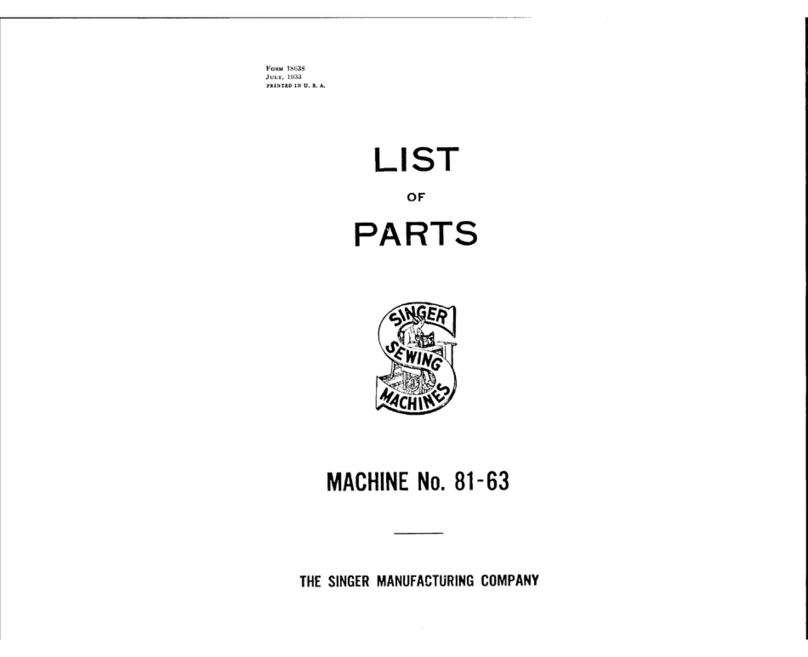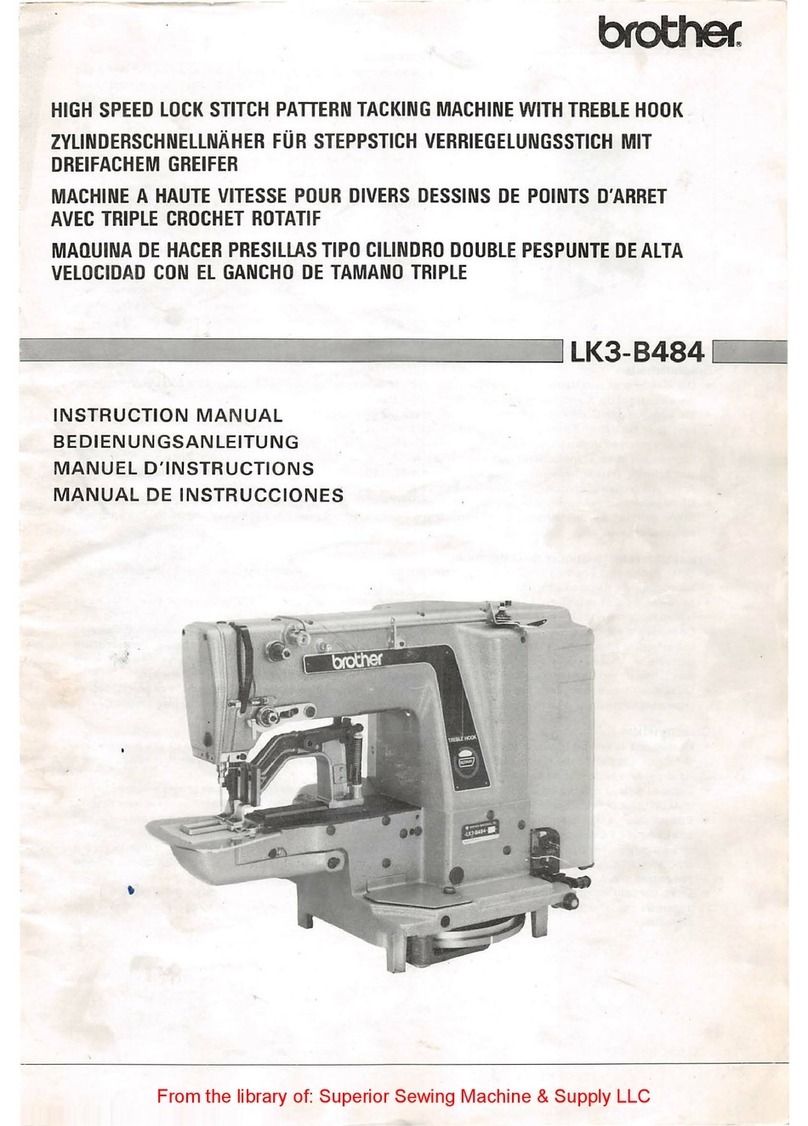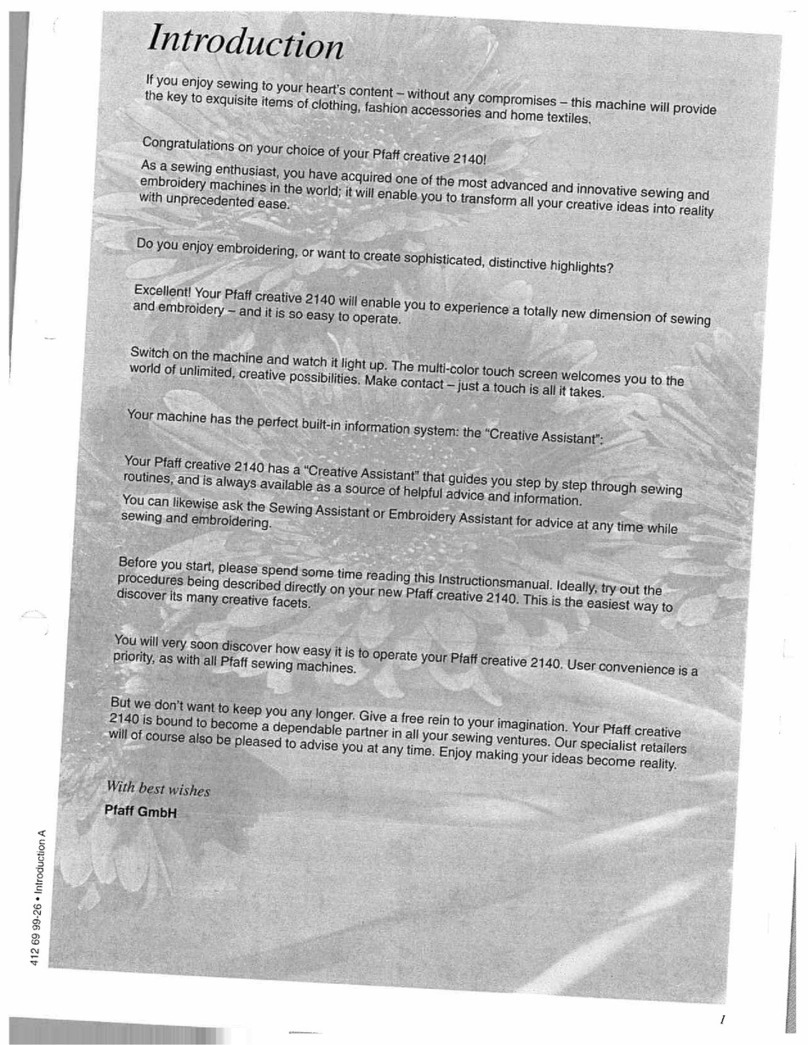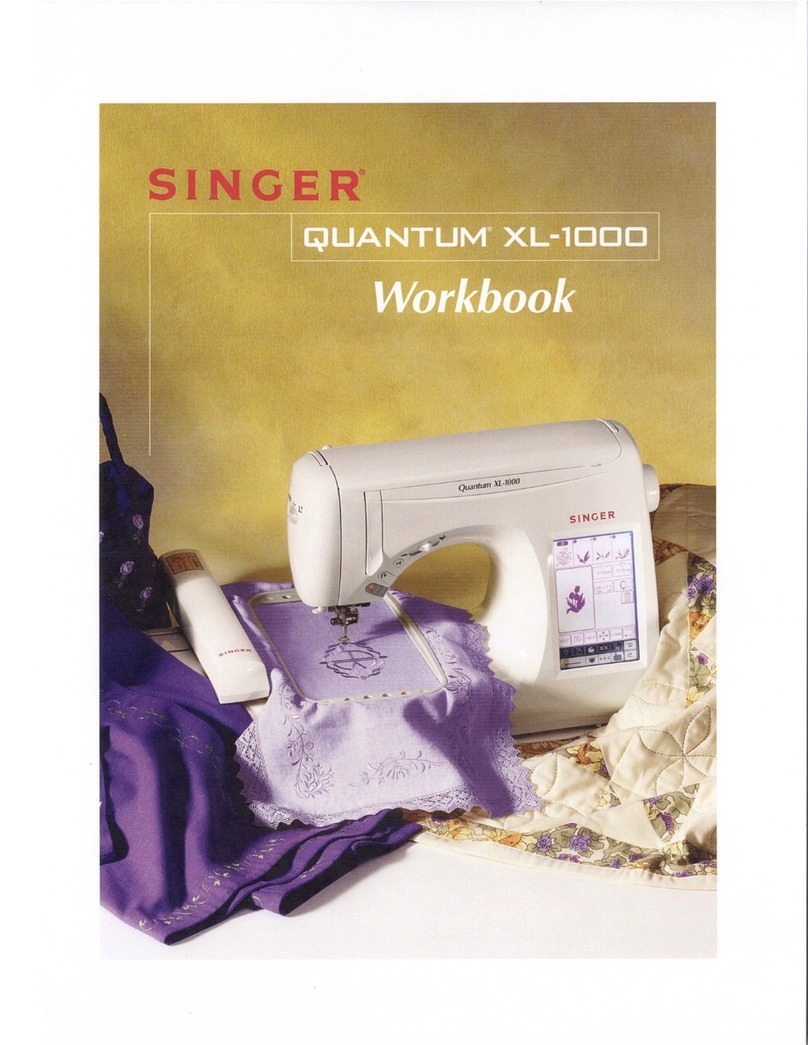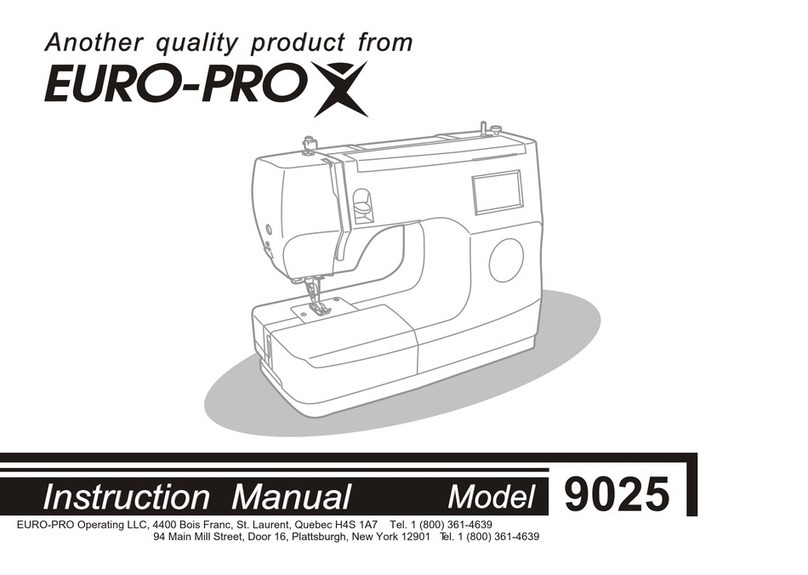VERITAS Elastica User manual

Instruction Manual
EN
overlock machine

We congratulate you on your purchase of your sewing machine.
You have bought a quality product which has been made with great care and, if
serviced right, will serve you well for many years.
Before using it for the first time, we ask you to read the manual at hand carefully,
paying special attention to the safety instructions.
Persons who are not familiar with this manual must not use the appliance.
In this manual, you will find everything there is to know about possible
applications of your sewing machine. Should any questions remain unanswered,
we kindly ask you to turn to your dealer.
We wish you much pleasure and great sewing successes!
Questions concerning machine, service and customer care
DEAR CUSTOMER
Service address: Veritas Service Center
c/o Teknihall GmbH
Breitefeld 15
DE-64839 Münster
GERMANY
Toll-free
customer service number: 00800 333 00 777
service-uk@veritas-sewing.com

Danger! Electric shock due to humidity
- The sewing machine must only be stored and used in dry rooms.
- Humidity and dampness may cause an electric shock.
Danger! Eye injuries due to a broken needle
- Only soft, flexible textiles may be sewn.
- The machine is not designed for sewing materials such as thick, hard or
inflexible leather, tarpaulins, canvas, etc.; the needle may break.
- The needle can break if the material is not transported by the motor and is
instead pushed or held back by the user.
Danger! Needle-prick injuries if operated accidentally
- The machine may only be used by careful adults.
- Children and persons with restricted abilities may only use the machine after
thorough instruction and under constant supervision.
- Never leave an operational machine in areas to which children have access.
- The main switch must be turned off for all preparation or configuration tasks.
Danger! Risk of injury due to defects or modifications.
- The machine must not be modified.
- Repairs must be carried out by the technical service.
- Damage, modifications, or the use of non-original accessories can lead to
injuries.
- Defective machines must no longer be used.
Danger! Unsuitable installation sites (workplaces) can result in accidents.
- The machine must only be operated when on a stable surface.
- Shaky, unstable or untidy workplaces can cause the machine to fall down or
cause needle-prick injuries.
Danger! Persons without knowledge of these operating instructions may
injure themselves or damage the sewing machine.
- Only use this sewing machine if you have a basic knowledge of how to use
sewing machines.
Danger! Needle-prick injuries may occur if you do not pay attention.
- Take time, ensure the workplace is tidy and guide the material calmly through
the machine without using force.
Caution! This machine is designed for use in a private home.
The machine is not approved for professional or commercial use.
INTENDED USE
EN

IMPORTANT SAFETY INSTRUCTIONS
When using an electrical appliance, basic safety precautions should always be followed, including the
following.
Read all instructions before using this sewing machine.
DANGER--To reduce the risk of electric shock:
1. Do not allow to be used as a toy. Close attention is necessary when this sewing machine is used
by or near children.
2. This appliance can be used by children aged from 8 years and above and persons with reduced
physical, sensory or mental capabilities or lack of experience and knowledge if they have been
given supervision or instruction concerning use of the appliance in a safe way and understand the
hazards involved. Children shall not play with the appliance. Cleaning and user maintenance
shall not be made by children without supervision.
3. Use this sewing machine only for its intended use as described in this manual. Use only
attachments recommended by the manufacturer as contained in this manual.
4. Never operate this sewing machine if it has a damaged cord or plug, if it is not working properly, if
it has been dropped or damaged, or dropped into water. Return the sewing machine to the nearest
authorized dealer or service center for examination,repair, electrical or mechanical adjustment.
5. Never operate the sewing machine with any air openings blocked. Keep ventilation openings of
the sewing machine and foot control free from the accumulation of lint, dust, and loose cloth.
6. Never drop or insert any object into any opening.
7. Do not use outdoors.
8. Do not operate where aerosol (spray) products are being used or where oxygen is being
administered.
9. To disconnect, turn switch to the off (”O”) position, then remove plug from outlet.
10. Do not unplug by pulling on cord. To unplug, grasp the plug, not the cord.
11. Keep fingers away from all moving parts. Special care is required around the sewing machine
needle.
12. Never sew with a damaged needle plate as this can cause needle to break.
13. Do not use bent needles.
14. Do not pull or push fabric while stitching. It may deflect the needle causing it to break.
15. Switch the sewing machine off (”O”) when making any adjustments in the needle area, such as
threading needle, changing needle, threading bobbin, or changing presser foot, etc.
16. Always unplug sewing machine from the electrical outlet when removing covers, lubricating, or
when making any other user servicing adjustments mentioned in the instruction manual.
17. Attention the following to avoid injury:
--switch off or unplug the appliance when leaving it unattended;
--unplug the appliance before carrying out maintenance.
CAUTION– Moving parts-To reduce risk of injury, switch off before servicing. Close
cover before operating machine.
SAVE THESE INSTRUCTIONS
This product is for household use, or equivalent.
This appliance complies with EMC Directive 2014/30/EU covering the
electromagnetic compatibility.
Please note that on disposal, this product must be safely recycled in accordance
with relevant National legislation relating to electrical/ electronic products. If in
doubt please contact your retailer for guidance.

1
SPECIFICATION OF MACHINE
Overedge stitch width (Max.)
MODEL ELASTICA
Number of threads 2, 3 or 4 threads
7mm(left needle)
HA1×SP, HA ×1(130/705H)
1-5mm
Up to 1100 stitches per minute
320 mm(W) ×280mm(D)×320mm(H)
9Kgs
Weight
Dimensions
Stitching speed
Stitch length
Needle
Identification chart………………………………………………………………………….…….2
Accessories……………………………………………………….………………….……………3
Setting up your machine…………………………………………….……………………………4
Preparation for threading……………………………………………………………………...5-6
Lint tray, Cutting width gauge……………………………………………………………......…7
Thread cutter, Changing presser feet……………………………………………………….…7
Changing needle, Needle thread and fabric chart………………………………………......8
Threading your machine…………………………………………………..………...……...9-11
Helpful hints……………………………………………………………………......…………...12
Cutting needle thread…………………………………………………………......…………...12
Testing stitch overlock stitches…………………………………………….....…….………..13
Setting chart………………………………………………………………………......……......14
Three-thread overlock with one needle………………………………………....…………...15
Converting to two-thread use………………………………………………….....…….……..15
Narrow and rolled hem, picot stitch……………………………………………......….……..16
Adjusting thread tensions………………………………………………………......………....17
Adjusting stitch length, Adjusting overedge cutting width, Stitch finger(B)………….....18
Differential feed……………………………………………………………………....……..19-20
Foot pressure regulator………………………………………………………………......…...20
Sewing with extra heavyweight fabric or multiple layers of fabric………………...……..20
Turning outside corners without cutting threads…………………………………..21
Turning curved edges, Removing stitches from sewn fabric……………………..21
Corded overlock………………………………………………………….....…………22
Decorative effects……………………………………………………………………..23
Differential feed applications………………….....………………………………….24
Replacing moving cutter, Disengaging moving cutter…………………………..………....25
Cleaning and oiling………………………………………....………………………….……....26
4. CHECKING PERFORMANCE PROBLEMS……………….………………………........27
TABLE OF CONTENTS
1. KNOWING YOUR MACHINE
2. STARTING TO SEW
Basic techniques
3. CARING FOR YOUR MACHINE

2
1. KNOWING YOUR MACHINE
IDENTIFICATION CHART
1. Foot pressure regulator
2. Thread cutter
3. Presser foot lever
4. LED lamp
5. Needle plate
6. Presser foot
7. Overedge cutting width dial
8. Working table
9. Thread guide pole
10. Left needle thread tension control
11. Right needle thread tension control
12. Upper Looper thread tension control
13. Lower looper thread tension control
14. Needle thread guides
15. Two thread convertor instruction
16. Threading chart
17. Lint tray
18. Foot control
19. Release lever
20. Foot release lever
21. Spool disc
22. Differential feed control dial
23. Stitch length dial
24. Hand wheel
25. Plug connector socket
26. Light and power switch
27. Front cover
28. Moving cutter
29. Lower looper
30. Upper looper
31. Cord guide
19
21
20
22
23
27
25
24
26
29
28
30
17
18
6
1
2
3
4
5
7
11
31 9
13
8
12
10
14
15
16

3
ACCESSORIES
1. Two-thread convertor
2. Stitch finger (B)
3. Needle set(option)
4. Brush(option)
5. Screwdriver (small)
6. Machine cover
7. Screwdriver (large)
8. Moving cutter
9. Spanner
10. Thread net
11. Tweezers
12. Spool disc
13. Spool holder
14. Accessory bag
6
78
11
9
13
12
10
14
1
2
3
45

4
SETTING UP YOUR
MACHINE
1. Wipe off excess oil in the needle
plate and bed areas.
2. FOOT CONTROL
Push foot control plug into
connector socket, and connect
the power line plug into power
supply outlet.
3. POWER/LIGHT SWITCH
Your machine will not operate
unless the power/light switch is
turned on. This same switch
controls both machine power and
sewing light.
When leaving the machine
unattended, or servicing the
machine, remove the power line
plug from supply outlet.
4. OPENING FRONT COVER
To open front cover, pull it to the
right and down towards you.
5. OPENING WORKING TABLE
To open working table, pull the
release lever towards you with
your right hand, and lift the front
of presser foot up with your left
hand.
Release lever
Working table
Front cover
Connector
socket
Power/light switch

5
PREPARATION FOR THREADING
THREAD GUIDE POLE
Pull up thread guide pole to the highest point
until you hear it click.
Place thread spools on pins and draw thread
through thread guides on the pole from rear
to front.
Thread guide of pole can hold hread spools
on the spool stand by pulling down the pole
as illustrated.
Thread guide
Thread guide pole

6
SPOOL CAPS FOR DOMESTIC TYPE
SPOOLS
SPOOL DISC AND SPOOL
HOLDERS FOR CONE SPOOLS
For large cone spools use the rubber spool
holders with the wide end at the top, and for
small ones, use the same rubber spool
holders but with the narrow end at the top.
SPOOL NETS
Polyester or bulky nylon threads become
loose while unwinding. To keep consistent
feeding of such threads, utilize spool net
sleeving over the spool.
Spool cap
Domestic cotton reel
Cone type thread
Spool holder
Spool disc
Thread comes off the top
Net
Net
Turn up
Spool Spool

7
LINT TRAY
With the lint tray located in this position it will
collect all your waste materials.
After completion of work, remove the lint tray.
CUTTING WIDTH GAUGE
When using cutting width gauge, the fabric is cut
down and sewn at same distance from the edge of
fabric.
Within the distance of the width adjusted.
THREAD CUTTER
Thread cutter is built in face cover. Draw
materials to the rear and cut off excess thread
with the thread cutter located on the bottom of
face cover as shown.
CHANGING PRESSER FEET
Be sure needle is in the up position.
Raise presser foot lever.
1. Push foot release lever to remove the foot.
2. Place the desired foot on the needle plate
aligning needle holes.
3. Lower the presser foot lever and push foot
release lever so that the foot holder snaps on
the foot.
Foot release lever
D

8
CHANGING NEEDLE
Raise needle bar to its highest point by turning hand wheel
towards you, but leave presser foot down. Loosen needle
clamp screw to remove the needle, and place new needle
with Flat Side Away From you, into the needle bar as far as it
will go, and tighten screw.
NEEDLE, THREAD AND FABRIC CHART
Use HA ×1 SP, HA ×1 (130/705H) Needles.
* Synthetic threads are recommended for ordinary overlocking. Polyester thread, for example, is very
useful for different types of fabric.
NOTE: Keep in mind that the lower and upper loopers will use about twice the amount of thread as the
needles. When purchasing thread for sewing, therefore, especially if it is an unusual colour, you
should buy sufficient for your requirements.
FABRIC THREAD NEEDLE
Cotton No.100
Polyester No.60-50
Cotton No.60
Polyester No.80
Cotton No.60
Polyester No.80-60
Cotton No.60
Polyester No.60-50
Cotton No.60
Polyester No.100-80
Cotton No.120-80
Polyester No.60
Cotton No.60
Polyester No.80-60
CottonNo.80-60
Polyester No.60-50
Cotton No.60
Polyester No.60-50
Bulk Nylon
Light weight: Organdy,
Lawn, Gingham
Heavy weight: Oxford,
Denim, Cotton Gabardine
Light weight: Tropical,
Wool, Poplin
Serge, Gabardine, Flannel
Heavy weight: Velours,
Camelhair, Astrakhan
Light weight: Georgette
Crape, Voile, Satin
Heavy weight: Taffeta,
Twills, Denim
Tricot
Jersey
Wool
COTTON
LINEN
WOOL
SYNTHETIC
FIBRE
KNIT
90(14)
for general sewing
75(11)
for light weight fabrics
Flat side away from you
Needle clamp screw

9
2. STARTING TO SEW
THREADING YOUR MACHINE
Wrong threading may cause skipped stitches,
breaking threads, or other problems.
Try to master the correct threading before moving on
to test sewing.
Threading must be carried out in the sequence of
Lower Looper – Upper Looper – Needle.
Open the front cover and the working table
Raise needle to its highest point by turning hand
wheel towards you, and raise the presser foot.
Before re-threading lower looper, remove thread from
needle eye first, then re-thread the lower looper. This
will prevent tangling.
STEP 1
THREADING LOWER LOOPER
1. Feed the thread through the thread guide as
illustrated.
2. Pull the lower thread through tension slot.
Holding the thread with your left hand, pull
down with right hand firmly.
3. Draw the thread through thread guide as
illustrated.
4. Pass the thread through lower looper eye,
and hook it around part A as indicated by the
arrow. Leave about 4” (10cm) extra thread.
3
4
A
2
1

10
STEP 2
THREADING UPPER LOOPER
1. Feed the thread through the thread guide as illustrated.
2. Pull the upper thread through the slot, holding the thread with your left hand.
3. Draw the thread through the thread guide as illustrated.
4. Pass the thread through wire thread guide and looper eye, leaving an excess length of about 4”(10 cm).
3
1
2
4

11
STEP 3and4
THREADING NEEDLES
1. Feed the thread through the thread guide as illustrated.
2. Draw the needle threads through left-hand tension slot. Holding the thread with your left hand, pull
down with right hand firmly.
3. Draw the thread through the thread guide as illustrated.
4. Thread the needles from front to back throug needle eye and pull the threads towards the back
passing along the right side of presser foot, leaving an extra length of about 4”(10cm).
43
1
2

12
HELPFUL HINTS
REPLACING THREAD SPOOLS
When replacing thread spools, the
following steps may be helpful for quick
changeover.
1. Cut off existing threads near the
spools. Tie the cut ends thread from
new spools as illustrated (seamen's
knot).
2. Raise presser foot.
3. Lower needle bar to its lowest
position by turning hand wheel away
from you. Carefully pull the existing
threads until the connecting knots
pass through needle eye and looper
eyes.
CUTTING NEEDLE THREAD
Frayed thread may make needle
threading difficult.
Draw the thread passing under the
thread cutter and turn hand wheel
towards you to obtain clear cut end as
illustrated.
3
12

13
TESTING STITCH OVERLOCK
STITCHES
After threading is completed, use a
scrap of fabric that you plan to sew and
test to sew in the following order.
1. Gently pulling all the threads to the
left, lower the presser foot. Rotate
the hand wheel towards you a few
times to see if the lock stitches are
properly formed.
2. Start the machine at low speed and
feed in test fabric under the presser
foot by slightly pushing it forward.
(This can be done with the presser
foot down on most fabrics except
bulky materials.)
Guide the fabric gently as machine
automatically feeds the material.
3. Check thread tensions by test sewing
on spare fabric. (See page 17.)
4. At fabric end, carry on running
machine at low speed, gently pulling
the fabric towards the back, until
about 5 to 6 cm of extra lock stitches
are produced without fabric.
5. Cut thread by thread cutter in face
cover, or with scissors.
Fig.1
Fig.2
Fig.3

14
1 2 346 7 89
10
11 12
5

15
THREE-THREAD OVERLOCK WITH ONE NEEDLE
By threading the LEFT needle only a width of 6 mm will be produced and by threading the
RIGHT needle only a width of 3.8 mm will be produced.
CONVERTING TO TWO-THREAD USE
To convert to two thread use, first open the front cover and working table and raise needle to its highest
point by turning hand wheel towards you. Remove the right needle and use the left needle.
Please keep the unused needle on the needle pad.
Pull out the convertor as shown in Fig.1.
Attach the two-thread convertor onto the upper looper as shown in Fig. 2, Fig.3.
When not using convertor, insert it deep and keep as illustrated in Fig.4.
Fig.1
1
2
Fig. 4
Fig. 3
Fig. 2
2
Two-thread
overlock
convertor
Upper
looser
1

16
RECOMMENDED THREAD
Narrow overlock edge
With Three Threads
Rolled edge
With Three Threads With Two Threads
Thread for needle
Upper looper
Lower looper
Polyester, Nylon, Silk No.50-100
Polyester, Nylon, Silk No.50-100
Bulk nylon (less stretchable)
Nylon No.100
Bulk nylon (less strechable)
NARROW AND ROLLED HEM, PICOT STITCH
Narrow and rolled edge is ideal for use on thin materials such as georgette crepe, crepe de chine, silk
etc.
Also, picot stitch can be produced particularly when sewing on fine 'scarflike' materials.
In view of the nature of these hems, they are unsuitable for use on 'hard' or 'heavy' materials.
1. Raise the presser foot.
2. Open the front cover and working table.
3. Remove the stitch finger from the needle plate by screw driver and keep it in the front cover as
illustrated (Model 320 only) or in the accessory bag.
4. Set the machine according to page 14.
NOTE: 1. Please use following recommended thread for making ideal seams.
2. After finishing , reset the stitch finger in its place. Please ensure inserting it deep as illustrated
in Fig 1.
Cross section
Fig.1
Stitch finger(A) 12
Table of contents
Other VERITAS Sewing Machine manuals

VERITAS
VERITAS MyJanis Operator's manual

VERITAS
VERITAS Marie User manual

VERITAS
VERITAS Anna User manual
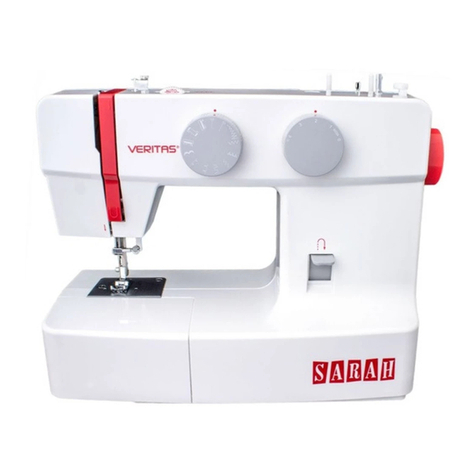
VERITAS
VERITAS Sarah User manual

VERITAS
VERITAS Rachel User manual

VERITAS
VERITAS Rachel User manual
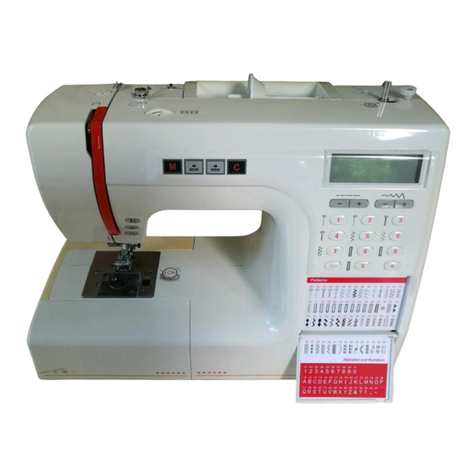
VERITAS
VERITAS 9000A5 User manual
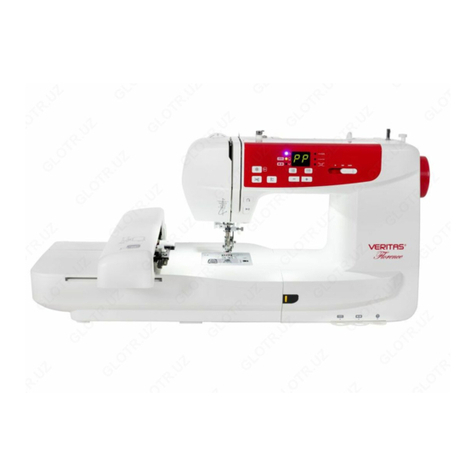
VERITAS
VERITAS Florence User manual
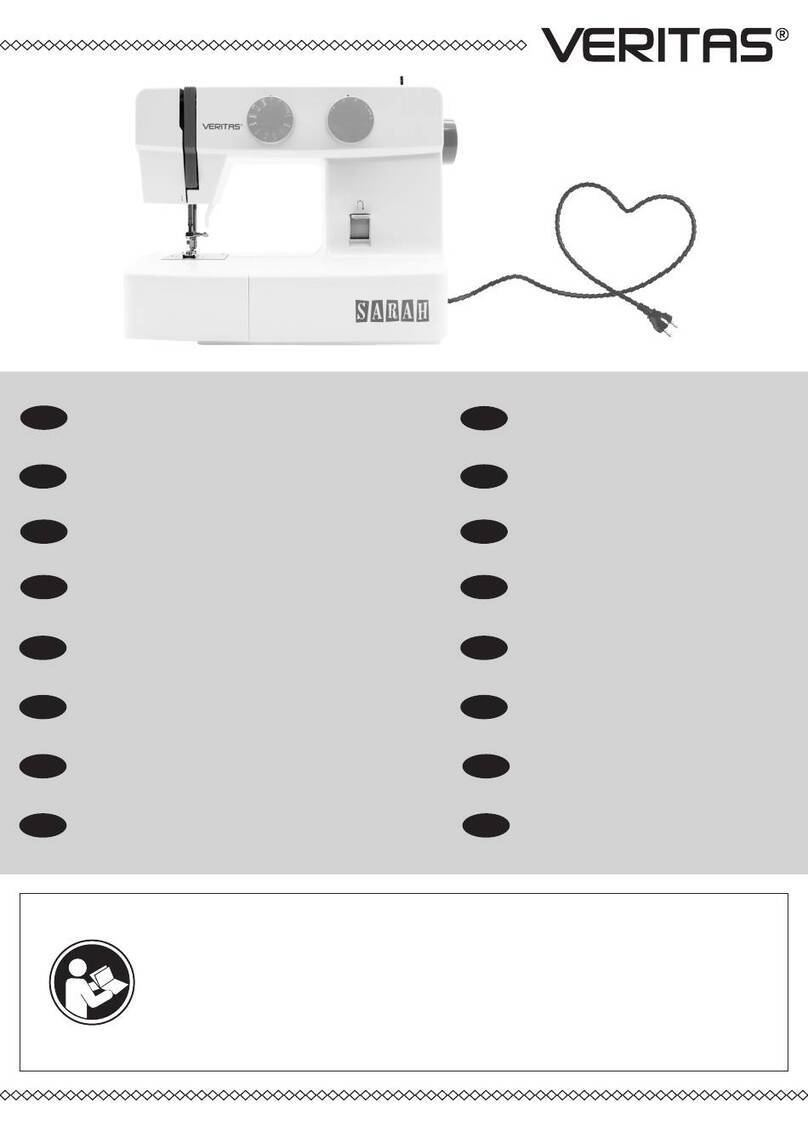
VERITAS
VERITAS Sarah Operator's manual
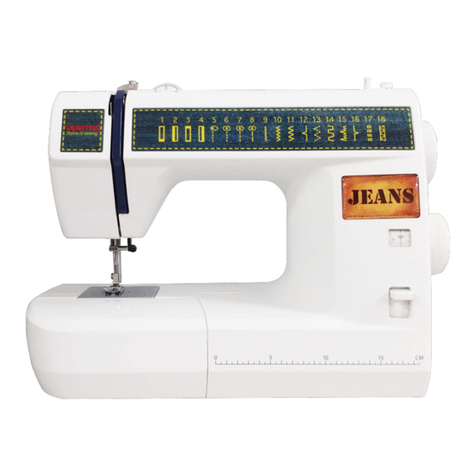
VERITAS
VERITAS JSA18 User manual

VERITAS
VERITAS JSB21 User manual

VERITAS
VERITAS Bessie User manual
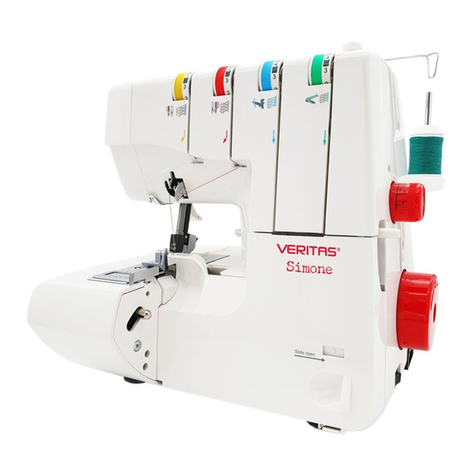
VERITAS
VERITAS Simone User manual

VERITAS
VERITAS Amelia User manual
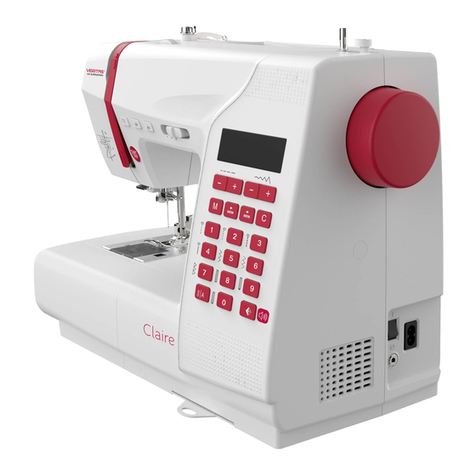
VERITAS
VERITAS Claire User manual

VERITAS
VERITAS Sarah User manual
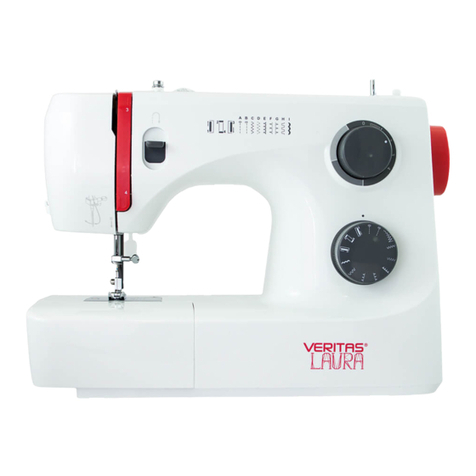
VERITAS
VERITAS Laura User manual

VERITAS
VERITAS Romy User manual

VERITAS
VERITAS Camille User manual
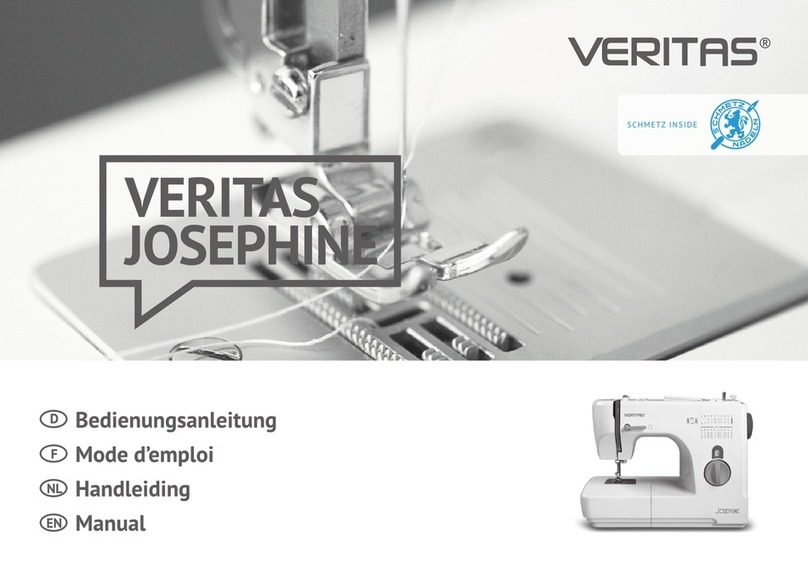
VERITAS
VERITAS Josephine User manual
